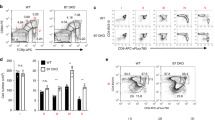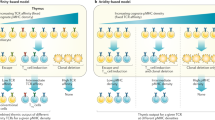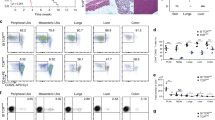Abstract
Potentially autoreactive T cells that escape negative selection in the thymus must be strictly controlled in the periphery to avoid autoimmune disease. The mostrobust regulatory process controlling autoreactivity is mediated by the CTLA-4-B7 pathway. The critical homeostasis mediated by CTLA-4 was proven using monoclonal antibodies and genetically disrupted CTLA-4 knockout mice that develop polyclonal lymphocyte activation and proliferation leading to massively enlarged lymph nodes and spleen and fatal multiorgan lymphocytic infiltrates. CTLA-4 ligation following T-cell activation down regulate scytokine production and cell-cycle progression, however, the proximal biochemical basis for robust T-cell regulation remains unclear. In this review, we summarize studies supporting a dynamic role for CTLA-4 at the immunological synapse leading to direct attenuation of early cell signals. A model is proposed based on these observations, which proposes that CTLA-4 may, in fact, function under some circumstances in aligand-independent manner. *** DIRECT SUPPORT *** A05Q2022 00011
Similar content being viewed by others
References
Harding FA, McArthur JG, Gross JA, Raulet DH, Allison JP: CD28-mediated signalling co-stimulates murine T cells and prevents induction of a nergy in T-cell clones. Nature 1992;356:607–609.
Noel PJ, Boise LH, Green JM, Thompson CB: CD 28: costimulation prevents cell death during primary T cell activation. J Immunol 1996;157:636–642.
Ding L, Shevach EM: Activation of CD4+ T cells by delivery of the B7 costimulatory signal on by stander antigen-presenting cells (trans-costimulation). Eur J Immunol 1994;24:859–866.
Sytwu HK, Liblau RS, McDevitt HO: The roles of Fas/APO-1 (CD95) and TNF in antigen-induced pro-grammed cell death in T cell receptor transgenic mice. Immunity 1996;5:17–30.
Nishimura H, Honjo T: PD-1: an inhibitory immunore-ceptorinvolved in peripheral to lerance. Trends Immunol 2001;22:265–268.
Walunas TL, Lenschow DJ, Bakker CY, Linsley PS, Freeman GJ, Green JM, et al.: C TLA-4 can function as a negative regulator of T cell activation. Immunity 1994;1:405–413.
Waterhouse P, Penninger JM, Timms E, et al.: Lymphoproliferative disorders with early lethality in mice deficient in Ctla-4. Science 1995;270:985–988.
Tivol EA, Borriello F, Schweitzer An, et al.: Loss of CTLA-4 leads to massive lympho proliferation and fatal multiorgan tissue destruction, revealing a critical negative regulatory role of CTLA-4. Immunity 1995;3: 541–547.
Karandikar NJ, Vanderlugt CL, Walunas TL, et al.: CTLA-4: a negative regulator of autoimmune disease. J Exp Med 1996;184:783–788.
Eagar TN, Karandikar NJ, Bluestone JA, Miller SD: The role of CTLA-4 in induction and maintenance of peripheral T cell tolerance. Eur J Immunol 2002;32:972–981.
Leach DR, Krummel MF, Allison JP: Enhancement of antitumor immunity by CTLA-4 blockade. Science 1996;271:1734–1736.
Bachmann MF, Waterhouse P, Speiser DE, McKall-Faienza K, Mak TW, Ohashi PS: Normal responsiveness of CTLA-4-deficient anti-viral cytotoxic T cells. J Immunol 1998;160:95–100.
Olsson C, Riesbeck K, Dohlsten M, et al.: CTLA-4 ligation suppresses CD 28-induced NF-kappaB and AP-1 activity in mouse T cell blasts. J Biol Chem 1999;274: 14400–14405.
Fraser JH, Rincon M, McCoy KD, et al.: C TLA4 ligation attenuates AP-1, NFAT and NF-kappaB activity in activated T cells. Eur J Immunol 1999;29:838–844.
Brunner MC, Chambers CA, Chan FK, Hanke J, Winoto A, Allison JP: CTLA-4-Mediated inhibition of early events of T cell proliferation. J Immunol 1999;162: 5813–5820.
Bour-Jordan H, Grogan JL, Tang Q, Auger JA, Locksley RM, Bluestone JA: CTLA-4 regulates the requirement for cytokine-induced sigrals in T(H) 2 lineage commitment. Nat Immunol 2003;4:182–188.
Linsley PS, Green JL, Brady W, Bajorath J, Ledbetter JA, Peach R: Human B7-1 (CD80) and B7-2 (CD86) bind with similar avidities but distinct kinetics to CD28 and CTLA-4 receptors. Immunity 1994;1:793–801.
Stamper CC, Zhang Y, Tobin JF, Erbe DV, Ikemizu S, Davis SJ, et al.: Crystal structure of the B7-1/C TLA-4 complex that inhibits human immune responses. Nature 2001;410:608–611.
Schwartz JC, Zhang X, Fedorov AA, Nathenson SG, Almo SC: Structural basis for co-stimulation by the human CTLA-4/B7-2 complex. Nature 2001;410:604–608.
Masteller EL, Chuang E, Mullen AC, Reiner SL, Thompson CB: Structural analysis of CTLA-4 function in vivo. J Immunol 2000;164:5319–5327.
Suresh M, Whitmire JK, Harrington LE, Larsen CP, Pearson TC, Altman JD, et al.: Role of CD28-B7 interactions in generation and maintenance of CD8 T cell memory. J Immunol 2001;167:5565–5573.
Alegre ML, Fraunwirth KA, Thompson CB: T-cell regulation by CD28 and CTLA-4. Nature Rev Immunol 2001;1:220–228.
Calvo CR, Amsen D, Kruisbeek AM: Cytotoxic T lymphocyte antigen 4 (CTLA-4) interferes with extracellular signal-regulated kinase (ERK) and Jun NH2-terminal kinase (JNK) activation, but does not affect phosphorylation of T cell receptor zeta and ZAP70. J Exp Med 1997;186:1645–1653.
Griffin MD, Hong DK, Holman PO, Lee KM, Whitters MJ, O'Herrin SM, et al.: Blockade of T cell activation using a surface-linked single-chain antibody of CTLA-4 (CD152). J Immunol 2000;164:4433–4442.
Tacke M., Clark GJ, Dallman MJ, Hunig T: Cellular distribution and costimulatory function of rat CD28. Regulated expression during thymocyte maturation and induction of cyclosporin A sensitivity of costimulated T cell responses by phorbol ester. J Immunol 1995; 154:5121–5127.
Chuang E, Lee KM, Robbins MD, Dverr JM, Alegre ML, Hambor JE, et al.: Regulation of cytotoxic T lymphocyte-associated molecule-4 by Src kinases. J Immunol 1999;162:1270–1277.
Lee KM, Chuang E, Griffin M, Khattri R, Hong DK, Zhang W, et al.: Molecular basis of T cell inactivation by CTLA-4. Science 1998;282:2263–2266.
Egen JG, Allison JP: Cytotoxic T lymphocyte antigen-4 accumulation in the immunological synapse is regulated by TCR signal strength. Immunity 2002;16:23–35.
Krummel MF, Davis MM: Dynamics of the immunological synapse: finding, establishing and solidifying a connection. Curr Opin Immunol 2002;14:66–74.
Linsley PS, Bradshaw J, Greene J, Peach R, Bennett KL, Mittler RS: Intracellular trafficking of CTLA-4 and focal localization towards sites of TCR engagement. Immunity 1996;4:535–543.
Zhang Y, Allison JP: Interaction of CTLA-4 with AP50, a clathrin-coated pitadaptor protein. Proc Natl Acad Sci USA 1997;94:9273–9278.
Chuang E, Alegre ML, Duckett CS, Noel PJ, Vander Heiden MG, Thompson CB: Interaction of CTLA-4 with the clathrin-associated protein AP50 results in ligand-independent docytosis that limits cell surface expression. J Immunol 1997;159: 144–151.
Schneider H, Martin M, Agarraheres FA, Yin L, Rapoport I, Kirchhausen T, et al: Cytolytic T lymphocyte-associated antigen-4 and the TCR zeta/CD3 complex, but not CD28, interact with clathrin adaptor complexes AP-1 and AP-2. J Immunol 1999;163:1868–1879.
Miyatake S, Nakaseko C, Umemori H, Yamamoto T, Saito T: Src family tyrosine kinases associate with and phosphorylate CTLA-4 (CD152). Biochem Biophys Res Commun 1998;249:444–448.
Wang XB, Zheng CY, Giscombe R, Lefvert AK: Regulation of surface and intracellular expression of CTLA-4 on human peripheral T cells. Scand J Immunol 2001;54:453–458.
Chikuma S, Murakami M, Tanaka K, Uede T: Janus kinase 2 is associated with a box 1-like motif and phosphorylates a critical tyrosine residue in the cytoplasmic region of cytotoxic T lymphocyte associated molecule-4. J Cell Biochem 2000;78;241–250.
Rigamonti L, Ariotti S, Losana G, Gradini R, Russo MA, Jouanguy E, et al.: Surface expression of the IFN-gamma R2 chain is regulated by intracellular trafficking in human T lymphocytes. J Immunol 2000;164:201–207.
Van Laethem F, Leo O: Membrane lipid rafts: new targets for immunoregulation. Curr Mol Med 2002;2: 557–570.
Bi K, Tanaka Y, Coudronniere N, Sugie K, Hong S, van Stipdonk MJ, et al.: Antigen-induced translocation of PKC-theta to membrane rafts is required for T cell activation. Nat Immunol 2001;2:556–563.
Viola A: The amplification of TCR signaling by dynamic membrane microdomains. Trends Immunol 2001;22: 322–327.
Tuosto L, Parolini I, Schroder S, Sargiacomo M, Lanzavecchia A, Viola A: Organization of plasma membrane functional rafts upon T cell activation. Eur J Immunol 2001;31:345–349.
Gomez-Mouton C, Abad JL, Mira E, Lacalle RA, Gallardo E, Jimenez-Baranda, S, et al.: Segregation of leading-edge and uropod components into specific lipid rafts during T cell polarization. Proc Natl Acad Sci USA 2001;98:9642–9647.
Viola A, Schroeder S, Sakakibara Y, Lanzavecchia A: T lymphocyte costimulation mediated by reorganization of membrane microdomains. Science 1999;283: 680–682.
Darlington PJ, Baroja ML, Chau TA, Siu E, Ling V, Carreno BM, et al.: Surface cytotoxic T lymphocyte-associated antigen 4 partitions within lipid rafts and relocates to the immunological synapse under conditions of inhibition of T cell activation. J Exp Med 2002;195: 1337–1347.
Chikuma S, Imboden JB, Bluestone JA: Negative regulation of T cell receptor-lipid raft interaction by cytotoxic T lymphocyte-associated antigen 4. J Exp Med 2003;197:129–135.
Drake DR, 3rd, Braciale TJ: Cutting edge: lipid raft integrity affects the efficiency of MHC class I tetramer binding and cell surface TCR arrangement on CD8+ T cells. J Immunol 2001;166:7009–7013.
Lee KH, Holdorf AD, Dustin ML, Chan AC, Allen PM, Shaw AS: T cell receptor signaling precedes immunological synapse formation. Science 2002;295: 1539–1542.
Marengere LE, Waterhouse P, Duncan GS, Mittrucker HW, Feng GS, Mak TW: Regulation of T cell receptor signaling by tyrosine phosphatase SYP association with CTLA-4. Science 1996;272:1170–1173.
Guntermann C, Alexander DR: CTLA-4 suppresses proximal TCR signaling in resting human CD4(+) T cells by inhibiting ZAP-70 Tyr(319) phosphorylation: a potential role for tyrosine phosphatases. J Immunol 2002;168:4420–4429.
Baroja ML, Vijayakrishnan L, Bettelli E, Darlington PJ, Chau TA, Ling V, et al.: Inhibition of CTLA-4 function by the regulatory subunit of serine/threonine phosphatase 2A. J Immunol 2002;168:5070–5078.
Chaung E, Fisher TS, Morgan RW, Robbins MD, Duerr JM, Vander Heiden MG, et al.: The CD28 and CTLA-4 receptors associate with the serine/threonine phosphatase PP2A. Immunity 2000;13:313–322.
Ugi S, Imamura T, Ricketts W, Olefsky JM: Protein phosphatase 2A forms a molecular complex with Shc and regulates Shc tyrosine phosphorylation and down-stream mitogenic signaling. Mol Cell Biol 2002;22: 2375–2387.
Shultz LD: Pleiotropic effects of deleterious alleles at the “motheaten” locus. Curr Top. Microbiol Immunol 1988;137:216–222.
Kosugi A, Sakakura J, Yasuda K, Ogata M, Hamaoka T: Involvement of SHP-1 tyrosine phosphatase in TCR-mediated signaling pathways in lipid rafts. Immunity 2001;14:669–680.
Stefanova I, Hemmer B, Vergelli M, Martin R, Biddison WE, Germain RN: TCR ligand discrimination is enforced by competing ERK positive and SHP-1 negative feedback pathways. Nat Immunol 2003;4:248–254.
Chambers CA, Allison JP: The role of tyrosine phosphorylation and PTP-1C in CTLA-4 signal transduction. Eur J Immunol 1996;26:3224–3229.
Frearson JA, Alexander DR: The phosphotyrosine phosphatase SHP-2 participates in a multimeric signaling complex and regulates T cell receptor (TCR) coupling to the Ras/mitogen-activated protein kinase (MAPK) pathway in Jurkat T cells. J Exp Med 1998;187:1417–1426.
Lacalle RA, Mira E, Gomez-Mouton C, Jimenez-Baranda S, Martinez AC, Manes S: Specific SHP-2 partitioning in raft domains triggers integrin-mediated signaling via Rho activation. J Cell Biol 2002;157: 277–289.
Sharpe AH: Analysis of lymphocyte costimulation in vivo using transgenic and ‘knockout’ mice. Curr Opin Immunol 1995;7:389–395.
Khattri R, Auger JA, Griffin MD, Sharpe AH, Bluestone JA: Lympho proliferative disorder in CTLA-4 knockout mice is characterized by CD28-regulated activation of Th2 responses. J Immunol 1999;162:5784–5791.
Tivol EA, Boyd SD, McKeon S, Borriello F, Nickerson P, Strom TB, et al.: CTLA4Ig prevents lymphopro liferation and fatal multiorgan tissue destruction in CTLA-4-deficient mice. J Immunol 1997;158:5091–5094.
Mandelbrot DA, McAdam AJ, Sharpe AH: B7-1 or B7-2 is required to produce the lymphoproliferative phenotype in mice lacking cytotoxic T lymphocyte-associated antigen 4 (CTLA-4). J Exp Med 1999;189: 435–440.
Murakami M, Takahashi Y, Isashi Y, Kon S, Jia WY, Inobe M, et al.: Identification and characterization of an altemalive cytotoxic T lymphocyle-associated protein 4 binding molecule on B cells. Proc Natl Acad Sci USA 1996;93:7838–7842.
Aoki Y, Isselbacher KJ, Cherayil BJ, Pillai S: Tyrosine phosphorylation of Blk and Fyn Src, homology 2 domain-binding proteins occurs in response to antigen-receptor ligation in B cells and constitutively in pre-B cells. Proc Natl Acad Sci U S A 1994;91:4204–4208.
Irving BA, Alt FW, Killeen N: Thymocyte development in the absence of pre-T cell receptor extracellular immunoglo bulin domains. Science 1998;280:905–908.
Saint-Ruf C, Panigada M, Azogui O, Debey P, von Boehmer H, Grassi F: Different initiation of pre-TCR and gammadelta TCR signalling Nature 2000;406:524–527.
Ueda H, Howson JM, Esposito L, et al.: Association of the T-cell regulatory gene CTLA4 with susceptibility to autoimmune disease. Nature 2003;423:506–511.
Author information
Authors and Affiliations
Rights and permissions
About this article
Cite this article
Chikuma, S., Bluestone, J.A. CTLA-4 and tolerance. Immunol Res 28, 241–253 (2003). https://doi.org/10.1385/IR:28:3:241
Issue Date:
DOI: https://doi.org/10.1385/IR:28:3:241




